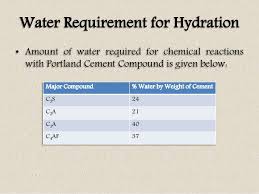It has been brought out earlier that CS requires 24 of water by weight of cement and C,S requires 21%. It has also been estimated that on an average 23% of water by weight of cement is required for chemical reaction with Portland cement compounds.
This 23% of water chemically combines with cement and therefore it is called bound water. A certain quantity of water is imbibed within the gel-pores. This water is known as gel-water. It can be said that bound water and gel-water are complimentary to each other. If the quantity of water is inadequate to fill up the gel-pores, the formations of gel itself will stop and if the formation of gel stops there is no question of gel-pores being present. It has been further estimated that about 15 percent by weight of cement is required to fill up the gel pores. Therefore, a total 38 percent of water by weight of cement is required for the complete chemical reactions and to occupy the space within gel-pores. Of water equal to 38 percent by weight of cement is only used It can be noticed that the resultant paste will undergo full hydration and no extra water will be available for the formation of undesirable capillary cavities. On the other hand, if more than 38 percent of water is used, then the excess water will cause undesirable capillary cavities. So the greater the water above the minimum required (38 percent), the more will be the undesirable capillary cavities. In all this it is assumed that hydration is taking place in a sealed container, where moisture to and from the past does not take place.





